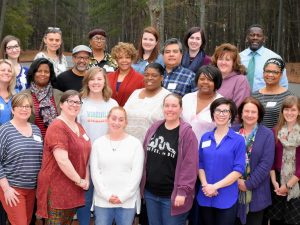Workshop on Al-Andalus Explores History and Culture of Islamic Spain
March 31, 2020
Center for Middle East and Islamic Studies

On Monday, March 2, 2020, K-12 teachers from across North Carolina convened at the National Humanities Center in the Research Triangle Park for a daylong workshop on Al-Andalus, the name given to Spain during 800 years of Islamic rule during the Middle Ages.
While attending sessions with university faculty, teachers explored the flourishing of art, culture, philosophy and science during this time period and discussed a variety of resources and activities to integrate this content into the classroom.
“The National Humanities Center creates opportunities for scholars and educators to collaborate, resulting in a deeper understanding on both contemporary and classic questions,” shared Andy Mink, vice president for education programs at the National Humanities Center. “Teachers at all levels need resources and the context on how to use these resources; similarly, scholars benefit from pedagogical discussions that impact their own classrooms.”
Al-Andalus was a multicultural civilization. Several groups have occupied the Iberian Peninsula over time, from the Visigoths to the Umayyads, each leaving their mark on the diverse cultures of Spain. “Using art, architecture, history and culture are essential lenses to understanding the modern Middle East,” Mink added.
Laura Lieber, professor of religious studies and director of the Center for Jewish Life at Duke University, discussed the Jewish community living in Spain during Islamic rule and the nature of coexisting, or convivencia, among various cultural groups. Lieber noted the importance of language, such as Judeo-Spanish, a form of Spanish mixed with Hebrew (and several other languages after Jewish communities were expelled from Spain in 1492), and documentation of these linguistic influences in cultural histories.
The workshop also featured scholar Michele Lamprakos, associate professor at the School of Architecture, Planning and Preservation at the University of Maryland-College Park and visiting fellow at the National Humanities Center. Trained as an architect and architectural historian, she specializes in the Arab-Islamic world and critical heritage studies. Providing an overview of the Mosque, Cathedral of Córdoba, Lamprakos emphasized the use of architecture and the transformation of buildings and places as a way to teach history.
The final session of the workshop explored issues of cultural diversity, tolerance and conflict in southern Spain today. Cristina Carrasco, teaching associate professor of Spanish, and Elena Peña-Argüeso, graduate student in the Department of Romance Studies at UNC-Chapel Hill, discussed recent immigration into Spain, highlighting migrants from the Middle East and North Africa.
“I learned so much background information on the coexistence of Moors, Christians, and Jews in southern Spain,” said Megan Zawierucha, a middle school Spanish teacher in Raleigh. “I feel better equipped to teach my annual unit on [Al-Andalus].”
This workshop was hosted by the Duke-UNC Consortium for Middle East Studies, the UNC Center for European Studies and the National Humanities Center.
